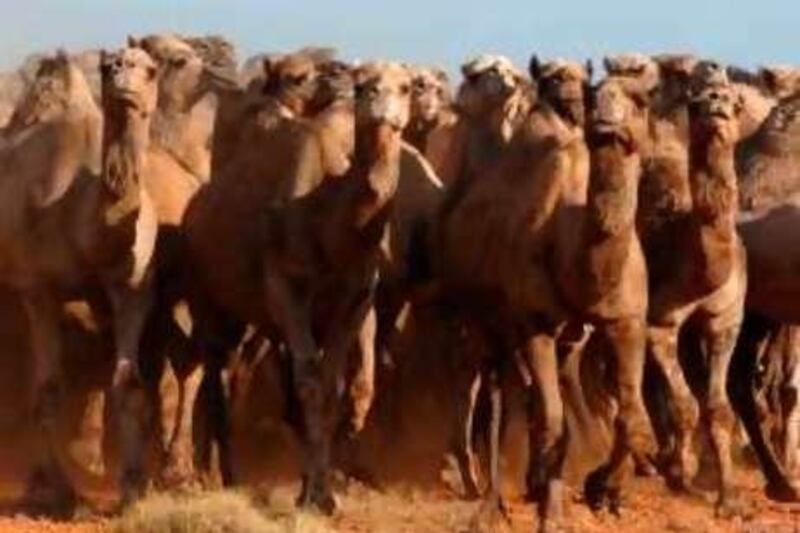SYDNEY // Australia's fledgling camel industry has demanded the government stop wasting millions of dollars culling feral herds in the outback and focus instead on boosting meat exports to the Middle East. An estimated one million camels roam across a giant swathe of Australia's barren interior, where they have become one of the continent's most destructive invasive pests, tearing up vegetation, fouling ponds and streams as well as besieging remote townships in search of water.
In response, the authorities have ordered marksmen to kill two-thirds of the wild camel population in a five-year eradication programme. Meat exporters, however, believe a more effective way to address Australia's camel crisis is to export them as part of a carefully controlled business, rather than simply shoot them and leave their bodies to decompose in the desert. "At the moment the camel industry in Australia is really struggling to become a commercial industry because of the lack of government support and the wasting of money in the culling of camels," said Paddy McHugh, whose abattoir in Queensland ships camel cuts and milk to the Middle East, Malaysia and Thailand. "It is most disgusting and immoral, culling these camels. The answer is to develop a commercial industry," he said.
"If they do cull 600,000 camels they would blow off the face of the Earth a billion dollars worth of exports for Australia that would be left to rot on the ground and cause disease. It is just disgraceful what is happening," added Mr McHugh, whose company uses helicopters to corral feral herds before loading the prized catch onto trucks, and transporting them to a processing factory. Mr McHugh said Australia's mass slaughter of "some of the purest camels in the world" was derailing efforts to take advantage of untapped demand in the United Arab Emirates, Saudi Arabia, Kuwait and Egypt.
"I've just got back from the Middle East and they are aghast at what is going on here. They want to invest in the industry here to solve the problems and take as much meat as we can supply but they are very reluctant to do it until we stop this stupidity of culling the camels," said Mr McHugh. His frustrations are shared by industry colleagues, who also believe that Australia's destruction of camels was ruining lucrative trading opportunities.
"If I put camel meat on the barbecue people think it is beef. One of the positive things about camel is the fat in it is basically polyunsaturated, so it is quite healthy," explained Mike Eathorne, the general manager of Meramist Ltd, a meat exporter based in the Queensland town of Caboolture, who sells frozen produce to restaurants in the United States, Great Britain, France and Belgium as well as the Maldives and Canada.
"We have a lot of interest from the Middle East but I am turning down potential sales every week simply because I cannot get a consistent supply of livestock," said Mr Eathorne. "The Moroccan army would take two containers a week off me, which is 250 animals. I've had generals and government people here. I have actually signed a contract with them which I could not fulfil." Arabian camels were brought to Australia from India and the Middle East by British colonists in the 1840s to help explorers conquer the continent's unforgiving outback. Studs were established to bolster the presence of an invaluable pack animal, which was ultimately made redundant with the advent of roads and railway lines. Let loose in the wilderness, the single-hump dromedaries have thrived in Australia, where scientists have estimated their numbers double every seven or eight years.
"Australia has a history of invasive animals doing very, very well here. People know about rabbits and foxes. There were no natural predators for camels in our outback. The climate is extremely suitable to them but the trouble is the native vegetation just doesn't cope with the camels. They are doing enormous damage to the landscape," explained Dr Tony Peacock, the chief executive of Australia's Co-operative Research Centres Association.
Dr Peacock has doubts that harvesting wild herds could be financially viable when they were spread across such a vast, inaccessible area. "Would people go six times across France to get a steak or to harvest a cow? "You couldn't do it economically with the cost of the fuel. The reality of accessing the camels that are literally in the middle of nowhere and slaughtering them with good welfare and food safety, then transporting that meat just becomes uneconomic in most cases," Dr Peacock insisted.
Breeding programmes have been set up in Australia to establish domesticated herds, but exporters have their sights firmly set on cashing in on the burgeoning feral population, but have insisted their efforts will fail without more generous government backing. "The top camel in the world is worth about AUD$8 million [Dh28m] for racing and the best beauty camel in the world is worth about $5m. In Australia they are worth a bullet in the head," Mr McHugh said.
@Email:foreign.desk@thenational.ae





